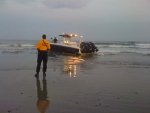toneeees
Administrator
- Joined
- Mar 15, 2011
- Messages
- 3,024
Running aground is ranked by the US Coast Guard as one of the top five boating accident types. It?s so common that experienced boaters will be quick to tell you that if you haven?t run aground yet, you eventually will? so you might as well be prepared!
Follow these ?dos? and avoid these ?don?ts? the next time you find yourself stuck in the mud (or rocks or reef):

DON?T put the boat in reverse
Your first thought after realizing you?re stuck may be to throw the boat in reverse? but don?t do that! Throwing the engine in reverse when you?ve run aground could potentially damage your propellers. Instead, stop the engine and lift the outdrive motor.
DO make sure everyone is safe
Take a few moments to make sure that all of your passengers are safe, sound, and wearing life jackets. You can replace a boat, but you can?t replace a human life!
DO check for leaks
Was there a hard impact? Is your boat taking on water? Then you may have a leak. It?s a good idea to check the boat for any cracks or loose parts.
DON?T move toward the point of impact
It may be tempting for everyone onboard to gather around the side of the boat to see what?s happened, but extra weight at the point of impact can push you further aground. Shift the weight on the boat to an area farthest away from the point of impact.
DO try and free yourself
If you don?t have a leak, you can attempt to free yourself by pushing off from a rock, bottom, or reef with a paddle or boat hook. This is where shifting the weight away from the point of impact really comes into play. Moving weight away from the collision makes it more likely that you?ll be able to push off.
DO call for help
If you just can?t break free, don?t panic! You can summon help using your visual distress signals, a mobile phone, and/or call for assistance using your VHF marine radio.
.
Next time you run aground?and let?s be honest, you will run aground?use these tips to help refloat your boat!
Want more boat safety tips? Start your safe boating course for free at Boat Ed?.
Follow these ?dos? and avoid these ?don?ts? the next time you find yourself stuck in the mud (or rocks or reef):

DON?T put the boat in reverse
Your first thought after realizing you?re stuck may be to throw the boat in reverse? but don?t do that! Throwing the engine in reverse when you?ve run aground could potentially damage your propellers. Instead, stop the engine and lift the outdrive motor.
DO make sure everyone is safe
Take a few moments to make sure that all of your passengers are safe, sound, and wearing life jackets. You can replace a boat, but you can?t replace a human life!
DO check for leaks
Was there a hard impact? Is your boat taking on water? Then you may have a leak. It?s a good idea to check the boat for any cracks or loose parts.
DON?T move toward the point of impact
It may be tempting for everyone onboard to gather around the side of the boat to see what?s happened, but extra weight at the point of impact can push you further aground. Shift the weight on the boat to an area farthest away from the point of impact.
DO try and free yourself
If you don?t have a leak, you can attempt to free yourself by pushing off from a rock, bottom, or reef with a paddle or boat hook. This is where shifting the weight away from the point of impact really comes into play. Moving weight away from the collision makes it more likely that you?ll be able to push off.
DO call for help
If you just can?t break free, don?t panic! You can summon help using your visual distress signals, a mobile phone, and/or call for assistance using your VHF marine radio.
.
Next time you run aground?and let?s be honest, you will run aground?use these tips to help refloat your boat!
Want more boat safety tips? Start your safe boating course for free at Boat Ed?.



















